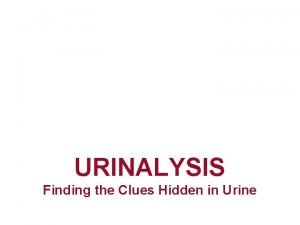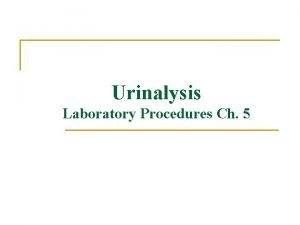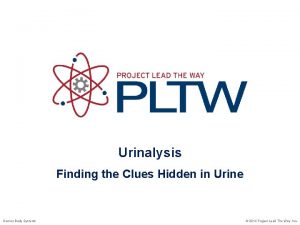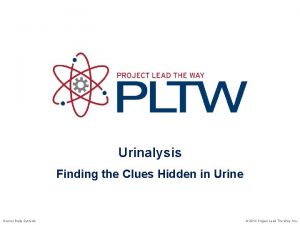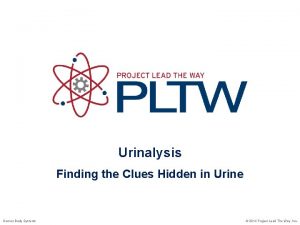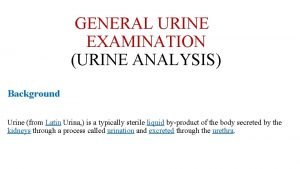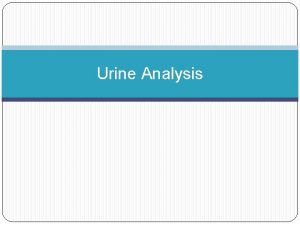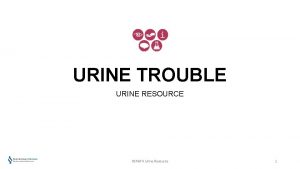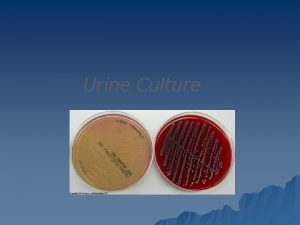URINALYSIS Finding the Clues Hidden in Urine What













- Slides: 13

URINALYSIS Finding the Clues Hidden in Urine

What is a Urinalysis? • Urinalysis: A test that determines the content of the urine. – Because urine removes toxins and excess liquids from the body, its contents can provide vital health information. – Urinalysis can be used to detect some types of disease, particularly in the case of metabolic disorders and kidney disease. – Urinalysis can also be used to uncover evidence of drug abuse.

Kidney Function • The role of the kidneys is to maintain homeostasis by controlling the chemical composition of the blood. The kidneys do this by: – Removing waste products from the blood – Leaving nutrients such as proteins and glucose in the blood – Maintaining the acid-base balance – Regulating water and electrolyte balance

Proper Kidney Function • Therefore, if the kidneys are functioning properly and person is in good over-all health, urine will be normal. • If urine shows abnormalities, this can indicate problem with kidneys. The following conditions can cause kidney problems: – Congestive heart failure – Injury to glomerulus or tubules from drugs, heavy metals, and viral infections. – Diabetes, hypertension, and kidney stones

Urinalysis Basics • Urinalysis consists of the following components: – Macroscopic Examination – Chemical Analysis – Microscopic Examination

Macroscopic Examination • Looking at the physical properties of the urine: – Color: • Normal urine should be a shade of yellow ranging from a straw to amber color. • Abnormal urine can be: colorless, dark yellow, orange, pink, red, green, brown, or black. – Clarity (transparency): • Normal urine should be clear • Abnormal urine can be: hazy, cloudy, or turbid

Chemical Analysis • The chemical properties of urine, including p. H, specific gravity, protein content, glucose content, ketone content, are tested. • Urine test strips are often used to detect the chemical properties of urine.

Parts of Chemical Analysis • p. H – Test measures if urine is acidic, basic or neutral – Normal urine ranges from 4. 6 to 8. 0 • Specific Gravity: – Test measures the concentration of particles in the urine and evaluates the body’s water balance. – The more concentrated the urine, the higher the urine specific gravity. – The most common increase in urine specific gravity is the result of dehydration. – Normal urine ranges between 1. 002 to 1. 028

Parts of Chemical Analysis • Ketones: – Test measures the presence or absence of ketones, the endpoint of rapid or excessive fat breakdown, in the urine. – Normal urine does not contain ketones • Protein: – Normal urine levels of proteins (called albumin) are very small, usually approximately 0 to 8 mg/dl.

Parts of Chemical Analysis • Glucose: – The test measures the amount of sugar in a urine sample. – Normal urine does not contain glucose.

Microscopic Examination • A variety of normal and abnormal cellular elements may be seen in urine when looked at under a microscope, including: – Red blood cells – White blood cells – Epithelial cells – Crystals – Bacteria

Microscopic Examination • Red blood cells are not found in normal urine. • White blood cells and bacteria, signs of infections, are not found in normal urine. • Epithelial cells are found in urine as they are the cells that line the urinary tract • Common crystals seen even in healthy patients include calcium oxalate, triple phosphate crystals and amorphous phosphates. – A large number of crystals, or certain types of crystals, may mean kidney stones are present or there is a problem with how the body is using food

Resources: • Urinalysis: Part 1. 2006 The University of Iowa (accessed 17 Aug 2007) Available from: http: //www. medicine. uiowa. edu/cme/clia/modules. asp? test. ID=19 • http: //www. utmem. edu/nephrology/documents/powerpoint-urinalysisfiles/frame. htm • http: //www. texascollaborative. org/spencer_urinalysis/ds_overview. ht m • http: //www. nlm. nih. gov/medlineplus/ency/article/003583. htm • http: //www. nlm. nih. gov/medlineplus/ency/article/003587. htm • http: //www. nlm. nih. gov/medlineplus/ency/article/003580. htm • http: //www. nlm. nih. gov/medlineplus/ency/article/003581. htm • http: //www. nlm. nih. gov/medlineplus/ency/article/003138. htm
 Context clues of urinalysis
Context clues of urinalysis Dari hasil tes ternyata pak jaka mengandung glukosa
Dari hasil tes ternyata pak jaka mengandung glukosa Boda-boda types of clues
Boda-boda types of clues Rock layers and fossils worksheet
Rock layers and fossils worksheet Normal specific gravity of urine
Normal specific gravity of urine Urinalysis sediment
Urinalysis sediment Urinalysis plural
Urinalysis plural Microscopic observations data sheet answers
Microscopic observations data sheet answers Treatments for acute renal failure
Treatments for acute renal failure Pyuria leukocytes urine
Pyuria leukocytes urine Upc certification
Upc certification Urinalysis lab
Urinalysis lab Why urinalysis is done
Why urinalysis is done Urinalysis
Urinalysis
